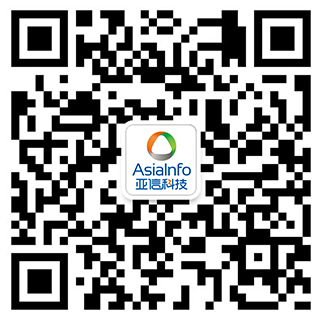上市一年,亚信科技(01675.HK)交出了一份靓丽的成绩单。
One year after its listing, AsiaInfo (01675. HK) presented a beautiful financial report.
On March 23, AsiaInfo released its 2019 result announcement, which was quite outstanding from business performance to financial data:
Revenue from software business was RMB 5.719 billion, up 10.1% year-on-year.
Profits reached RMB 409 million, up 100.2% year-on-year. Adjusted profit was RMB 673 million, an increase of 11.7% year-on-year.
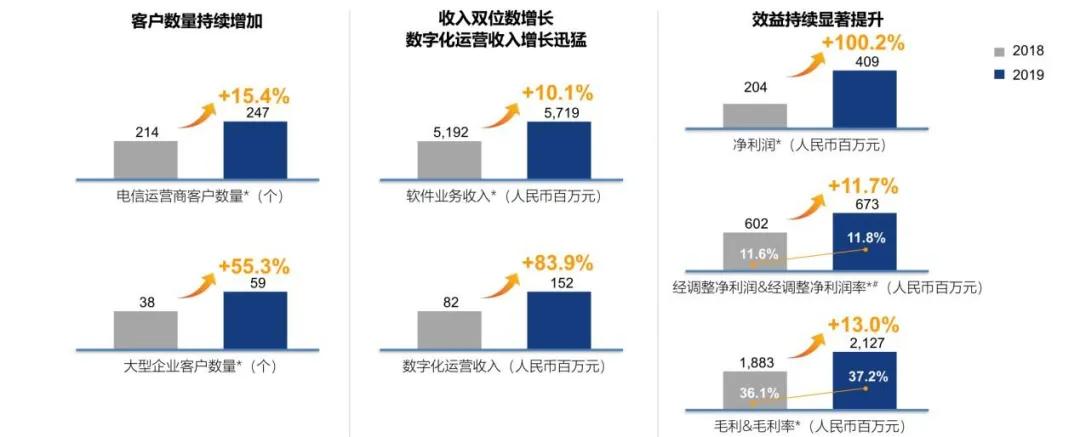
This is an extremely important financial report.
Over the past few years, AsiaInfo, one of China's largest telecom software giants, has been undergoing a profound and comprehensive transformation at a steady and resolute pace.
AsiaInfo put forward a brand-new goal at the end of last year: to build itself into a 10-billion-yuan worth enterprise in five years. Based on its revenue of RMB 5 billion in 2018, this means that AsiaInfo has to grow five times within 5 years.
Then, why can AsiaInfo's transformation be so effective? Where does its confidence come from?
【1】
In the spring of 2020, an epidemic changed the whole world.
Having effectively contained the spread of the epidemic, China has passed through the most difficult moment and ushered in the dawn.
In this thrilling war against COVID-19, an important reason for winning is that we have timely and accurately tracked the migrant population, especially the close contacts of confirmed patients and other potential high-risk groups, thus controlling the spread of the virus to the greatest extent.
Few people understood what technical challenges we were faced with
First of all, it means that all the user's identity data, location data, epidemic spread data, government management data and other data previously scattered in various institutions and operators have to be shared seamlessly. Moreover, there must be a perfect desensitization mechanism to ensure that users' privacy is not violated.
Secondly, it is a complicated task to use these massive data from different sources to realize the prevention and control of the epidemic: demands have to be sort out, rules clarified and algorithms trained.
Third, these data and algorithms must be quickly and stably added to the existing communication IT system for online use.
The third point alone was impossible a few years ago. It would take at least a few months to start a normal operator business -- from proposing the demand, project evaluation, research and development, to testing and finally to being released online.
This is because the IT system in the communication industry is extremely complex, and all links are highly coupled. In addition, it requires extremely high operation stability, which is just like changing tires while driving on the expressway. Therefore, in-depth customized development is needed.
After COVID-19 outbreak, AsiaInfo completed the modeling and training of the artificial intelligence identification algorithm for the migrant population and potential risk users in a district of a municipality directly under the Central Government in less than 10 hours. It took them less than 24 hours to complete the desensitization of the whole interactive data between the China Telecom and China Mobile users and their base stations, as well as the risk analysis of the potential population.
According to Mr. Ouyang Ye, CTO of AsiaInfo, the company has so far provided nearly 20 products in 5 stages for the national and local governments and operators to fight the epidemic, and these have been put into practical application in many national ministries and commissions:
In terms of epidemic perception, AsiaInfo is able to carry out epidemic monitoring in key areas, offer automatic discovery system for external population and 3D system in sensitive areas;
In terms of epidemic cognition, AsiaInfo has macro information and overview information of the epidemic situation, tracks the travel history of high-risk groups, and provides early warning system of epidemic infection risks, etc.
For epidemic prediction, AsiaInfo has the epidemic situation awareness system and the epidemic infection risk assessment system.
For anti-epidemic command, AsiaInfo has the global epidemic prevention command module, the epidemic information linkage system, the epidemic isolation and medical treatment system, as well as the rapid distribution system for epidemic materials.
For the resumption of production, AsiaInfo can provide the personnel management system in public places, the remote cooperative cloud office system and the epidemic prevention publicity and analysis systems, etc.
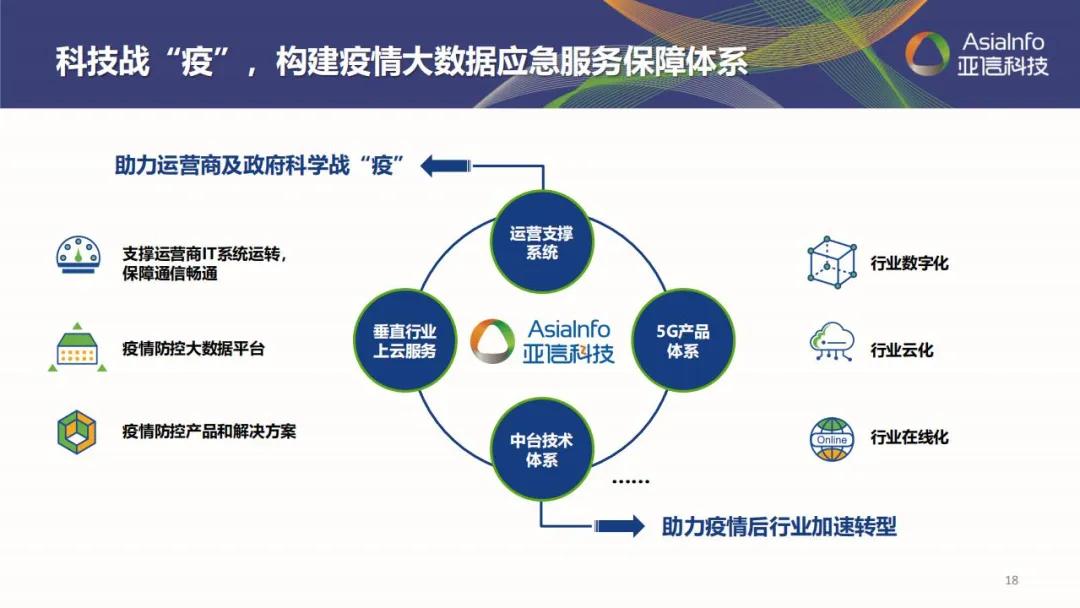
These specific products were developed in a very short period of time based the actual demands and then repeatedly applied in different systems as "rapid response" tools, which represents AsiaInfo's software and artificial intelligence technology as well as its executive ability, and this is also the reason why AsiaInfo has been promoting the upgrading and transformation of communication IT systems.
According to Tian Suning, chairman of AsiaInfo, in the 5G era, almost all key physical devices will be connected by the network, and more and more dimensions of data will become perceptible.
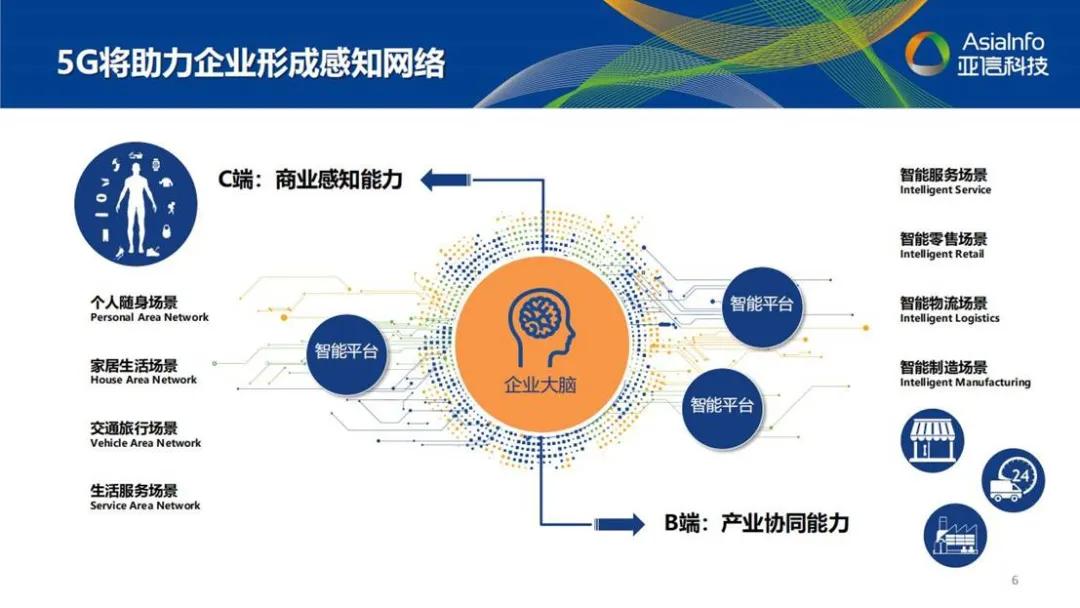
For enterprises, the process-driven internal management in the industrial era will gradually become the cognitive-driven management in the digital era. The network will become the key infrastructure, and the data will also become the basic means of production in the industrial age, like ore, land and oil.

But how to design, operate, manage and maintain these networks? How to perceive, transmit, store and calculate the data? All of these need to be completed through core software. Moreover, the response of these software will become more and more agile, the operation will become more and more intelligent, and the delivery form will also change, gradually changing from customized delivery to standardized delivery and then to operational delivery.
AsiaInfo hopes to seize 5G, a new opportunity for infrastructure investment and transformation, and become an enabler to help operators and enterprises to operate digitally.

【2】
Rome was not built in a day.
"We have been thinking about how to accumulate our years of business and service capabilities to make it more sustainable, evolvable and viable, instead of repeating the old demand over and over again," AsiaInfo Vice President Wang Liping once told me in an interview.
In March 2016, AsiaInfo officially released AIF (Infrastructure Platform) Version 1.0.
Before this, AsiaInfo had been providing customized services for operators. To put it simply, it is just like the contractor team building houses. If the operator has any needs, AsiaInfo will send someone to develop them and then collect the money by headcounts.
This enterprise-level distributed clouded PaaS platform independently developed by AsiaInfo was a new attempt.
It extracted the common capabilities and business logic that can be reused from the operator's IT system, precipitated, solidified and packaged them, and provided standard open interfaces for different upper-layer applications to retrieve, thus greatly reducing repeated development and shortening the time for business development and online release.
A year later, with an unprecedented high-profile attitude, AsiaInfo released seven products in February 2017, including the infrastructure platform, corporate customer operation product suite, development framework for intelligent terminal application, intelligent service & communication platform, billing product, and the intelligent measurement management platform.
On this basis, AsiaInfo's business has gradually changed from "software services" to "software products + services". On the one hand, it continues to serve operators, and on the other hand, AsiaInfo also unites operators to turn its technical accumulation in the telecommunications industry into products, providing empowerment for the digital transformation of more industries.
Within the company, however, under the leadership of CEO Gao Nianshu, the so-called "Mr. Key", the research and development personnel and business personnel previously scattered in different project teams have also been completely broken and reorganized according to the brand-new organizational structure of front desk, middle office and back office.
Development has accelerated.
In 2016, AsiaInfo was still losing money. In 2017, the company turned losses into profits. In 2018, AsiaInfo's revenue exceeded 5 billion yuan, and saw its net profit increase by 29.9% year on year.
Now, the wave of 5G upgrade has further brought development opportunities to AsiaInfo.
In June 2019, 5G network was officially put into commercial use in China. In the same month, AsiaInfo also released the 5G-oriented commercial product sets ranging from 5G billing, 5G communication artificial intelligence, 5G network intelligence, 5G big-data-stack to open source databases.
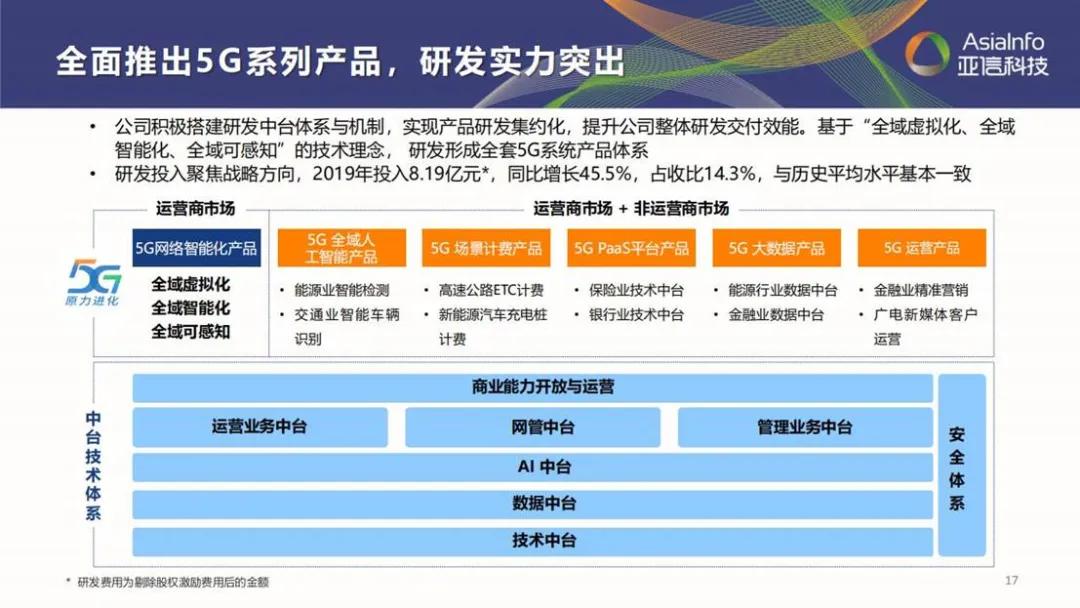
In the following six months, AsiaInfo has helped operators to commercialize a large number of 5G products and core systems.
For example, China's first 5G-oriented integrated billing commercial system was developed by AsiaInfo with the assistance of operators, and many commercial stations have been successfully commercialized in the field of network intelligence.
In addition to operators, AsiaInfo has also begun to enter various industries such as postal services, banking, insurance, radio and television, finance, electricity, medical care, real estate, retail, etc.
In the autumn of 2019, for example, China Post launched a brand-new CRM system to carry its strategic concept of "One Body, Two Wings", breaking all the barriers between the Group and its five major business sectors. This 440TB super-large system, which includes all 630,000 employees of China Post was built by AsiaInfo with the assistance of China Post.
【3】
In 2019, AsiaInfo put forward a development strategy for the 5G era: "One Consolidation and Three Developments".
In short, it is to consolidate the development of main business - the existing telecom BSS (Business Support System), and develop three emerging businesses in an all-round way:
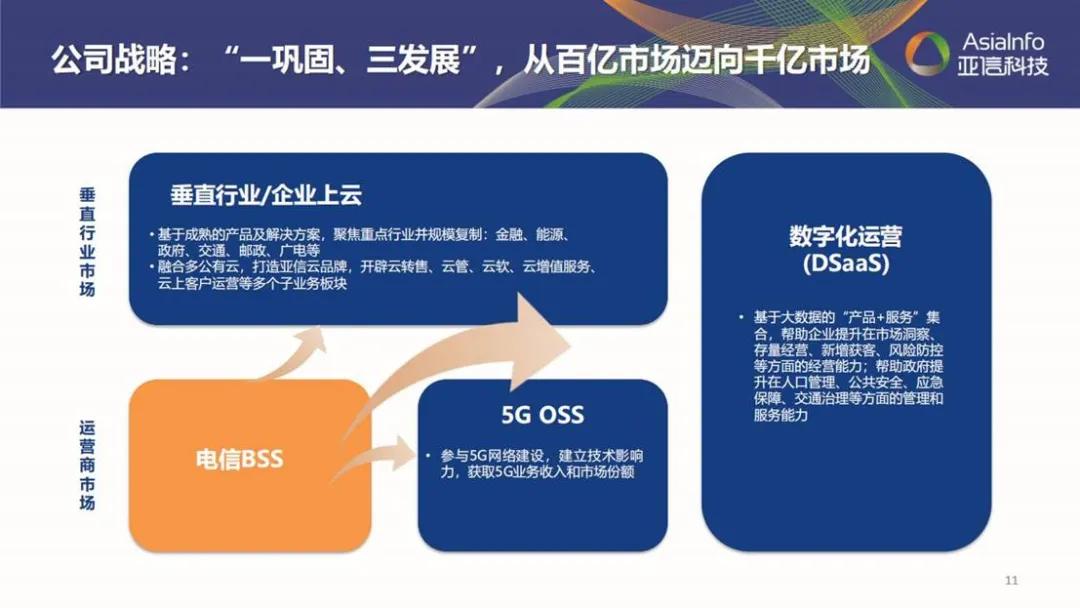
The first is the 5G OSS, 5G network domain;
The second is DSaaS (Digital Operation), which uses the product service and business scenario design of AsiaInfo to help customers realize data realization.
The third is vertical industries and introduction of enterprises to go to the cloud.
After one year, all business areas of the "One Consolidation and Three Developments" have seen sound development:
(1) Telecom BSS service.
In 2019, the number of telecom customers further increased to 247, up 15.4% year on year.
Gao Nianshu believes that the reasons why AsiaInfo can be one step ahead are 1) it actively participated in the top-level design and planning of operators and has already involved in the planning stage of transformation and upgrading of their IT systems; 2) it followed some external tendencies to promote operators to upgrade their networks, such as 5G and number portability, thus further consolidating the market.
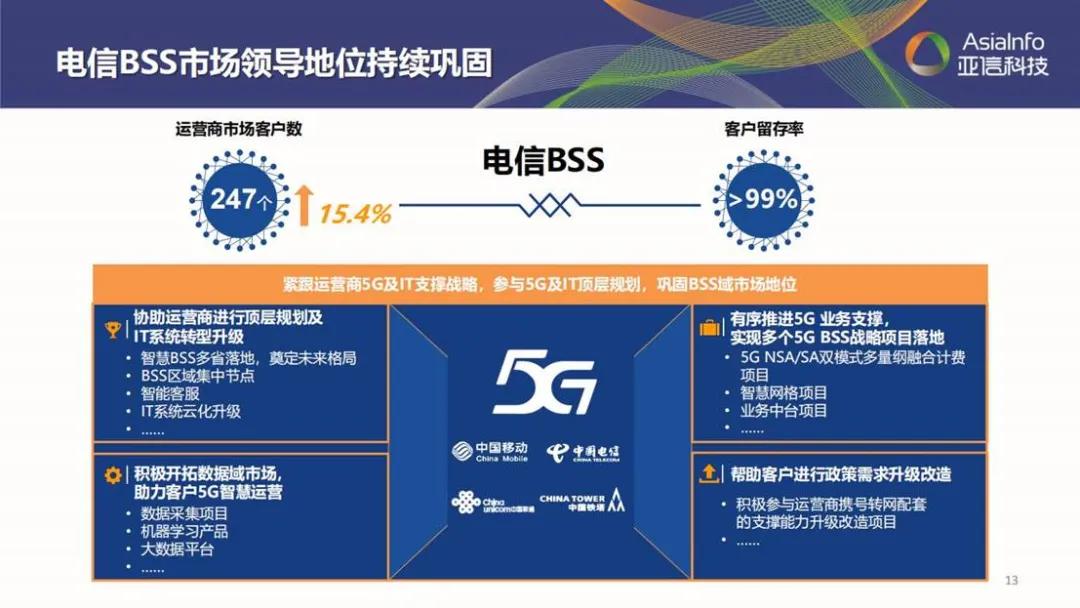
(2) 5G OSS service.
AsiaInfo has now launched six categories of products: network intelligent slicing, network performance management, network fault management, network resource management, customer experience management and network optimization.

In 2019, the actual development speed of OSS business far exceeds expectations. During the year, it was commercially available in 17 stations, including the earliest commercial 5G network slicing management system of Chinese operators, SDN network management system at the provincial level, 5G NR system of the whole network, NFV virtualization products, etc.
(3) DSaaS service.
In 2019, AsiaInfo's business revenue in this field has reached 152 million yuan, up 83.9% year on year. Mr. Gao Nianshu also predicted that the business would continue to grow at a high speed in 2020.
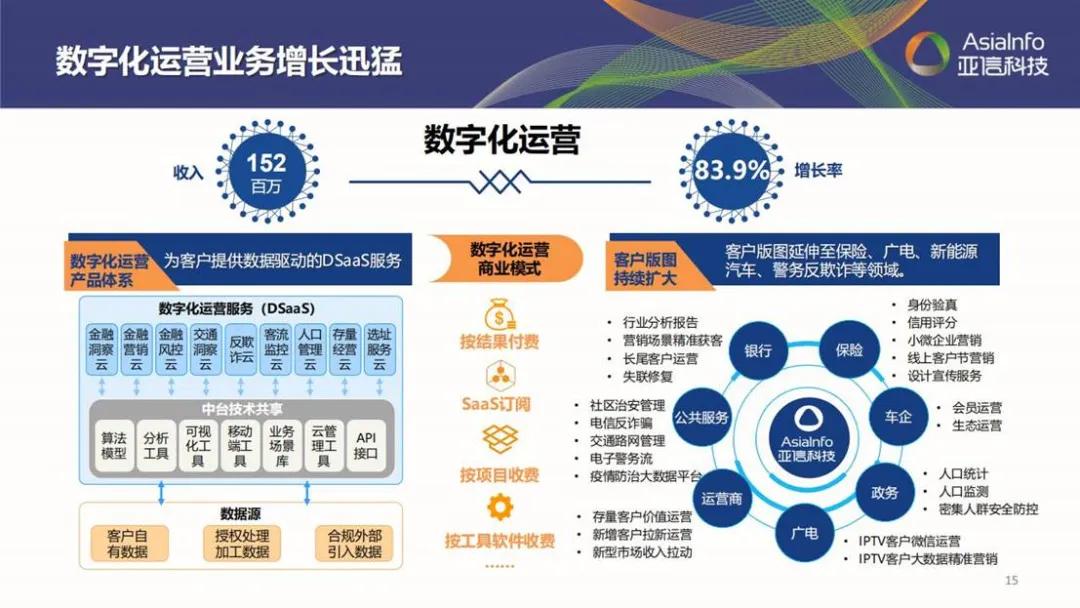
It is worth noting that, in addition to operators, AsiaInfo also provides these business services for insurance, banking, automobile, radio and television and other industries, and it has tried many business models, some are charged by project, some by tool software, and some by SaaS subscription.
(4) Guide vertical industries to cloud
In 2019, the number of customers from large non-operator enterprises has reached 59, an increase of 55.3%, and the retention rate has also exceeded 99%.
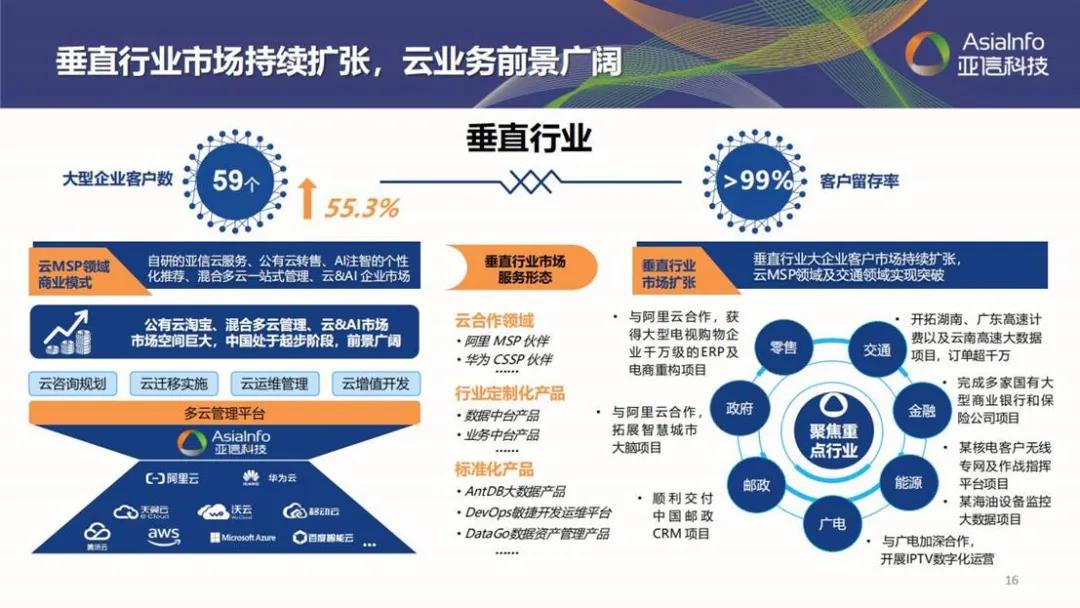
According to Cao Weiqi, vice president of AsiaInfo, the company will also use new technologies to build its own cloud business brand in 2020.
【4】
Whether it is the "One Consolidation or the "Three Developments", AsiaInfo's advantage lies in that it can use 5G technology to copy and output the advantages it has accumulated over the years.
"Many companies have their own products, but their ToB service capability to large enterprises is weak. While other companies have strong service capability but weak product capability. However, AsiaInfo has very strong accumulations in both developing products and providing services for large enterprises," said Gao Nianshu.
In his view, AsiaInfo has four core advantages in capability:
Product capability: AsiaInfo has a strong middle office for product research and development. On the one hand, it has accumulated a lot of capabilities and experiences with common needs, and has established a complete, powerful and standardized product pool. On the other hand, it also has a very strong new product development capability. The rapid response during the epidemic mentioned earlier is such an example.
Service capability: AsiaInfo has rich experience in serving super-large customers. It can customize and develop products based on customers' needs and complete delivery quickly.
Operational capability: In terms of making full use of data and tools, scene design capabilities, helping customers to attract new customers and promoting activity, AsiaInfo has established a complete business system, which can help customers in various industries to quickly realize digital operation, regardless of product library or operation experience.
Integration capability: AsiaInfo has no hardware gene or consumer-oriented Internet business. Therefore, it can pool resources from all sides and serve partners in all links of the industrial chain in a neutral capacity when facing operators, equipment manufacturers, cloud manufacturers and all walks of life.
AsiaInfo's middle office in technology, big data, AI and network services are all carried out in accordance with the overall research and development objectives of network neutrality, business neutrality and open source technology neutrality. Therefore, it has excellent openness in terms of middle office openness, interconnection and overall connectivity.
Especially when helping operators build network-neutral, service-neutral and manufacturer-neutral network management systems and do a good job in network management, network arrangement and network evolution, AsiaInfo can provide great help because many super-large enterprise customers often need to run business across operators, clouds and hardware platforms.
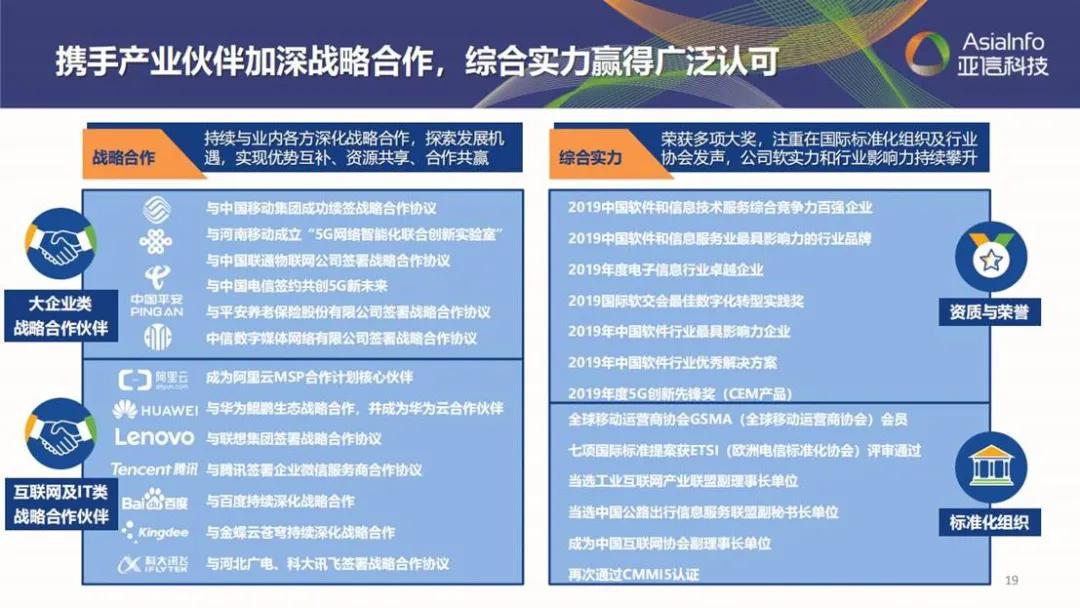
"In China, it is rare for a company to have these four capabilities at the same time," said Gao Nianshu.
At present, 5G, big data, cloud computing, edge computing, artificial intelligence and other information technologies have become the most important innovation engines in human society. In the future, every enterprise must embrace the network and digitalization.
Moreover, at this stage, it is no longer as simple as "every company has to surf the Internet", but enterprises need to realize digitization, intelligentization and operational step by step from management, production, purchase, sale and storage, finance, customer relations and other aspects.
To put it in another way, every enterprise will become an operator in its own industry.
The goal of AsiaInfo is to become the enabler of their digital transformation.
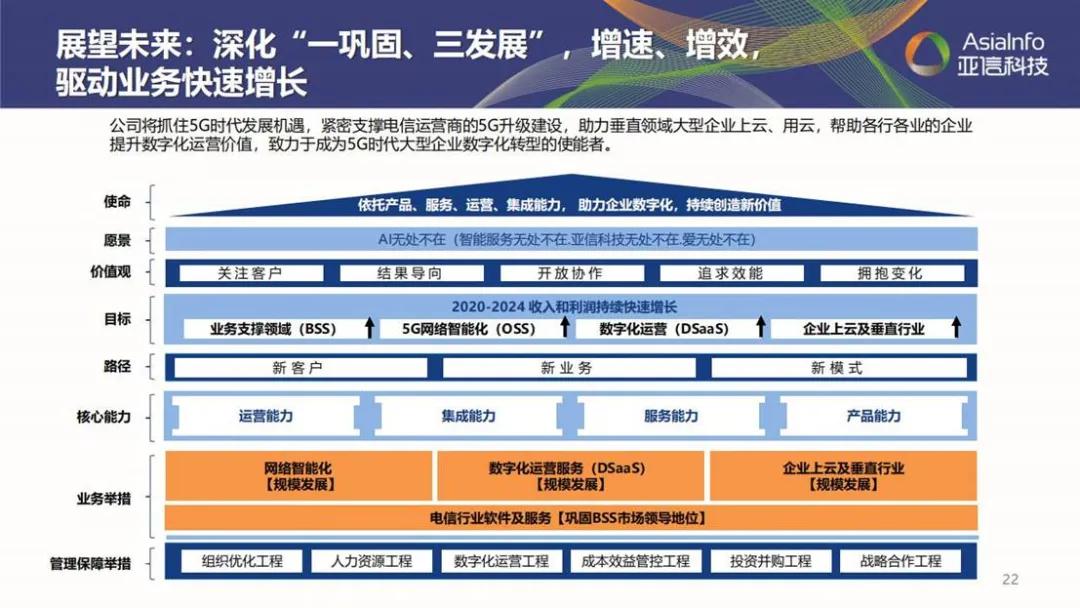
Especially in 2020, the demand for data operations triggered by the COVID-19 epidemic, the advancement of 5G commercial process, and the acceleration of the trend of enterprises going to the cloud have created new opportunities for AsiaInfo.
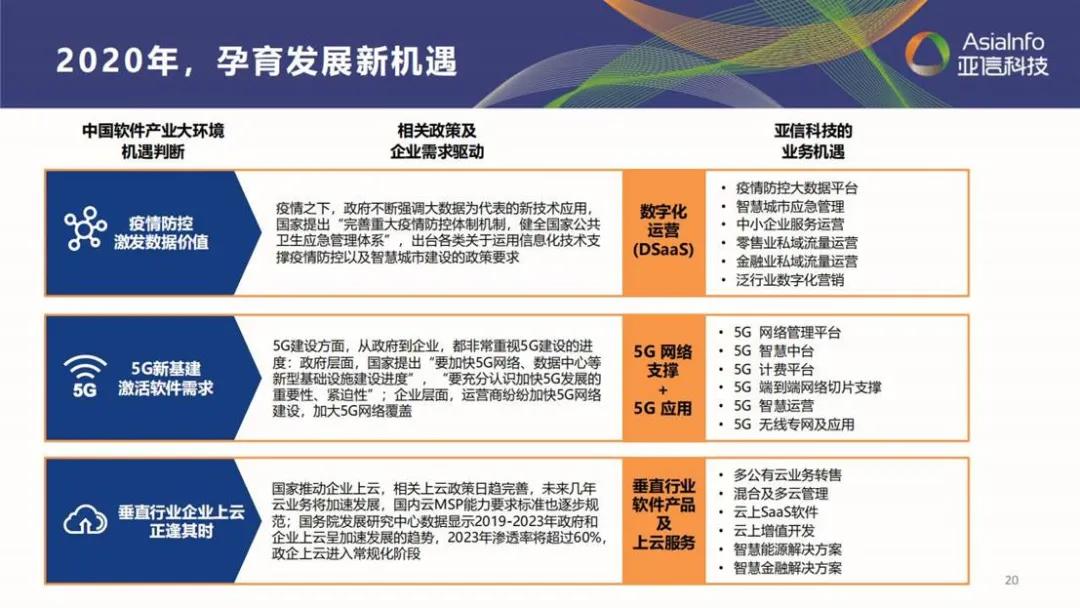
This is why AsiaInfo can achieve such rapid growth and has the confidence to double its performance in five years.
















